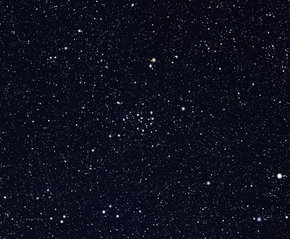NGC 5316
| NGC 5316 | |
|---|---|
 NGC 5316 | |
| Observation data (J2000epoch) | |
| Right ascension | 13h53m57s[1] |
| Declination | −61° 52′ 06″[1] |
| Distance | 3,960ly(1,215pc[2]) |
| Apparent magnitude(V) | 6.0[1] |
| Apparent dimensions (V) | 15'[3] |
| Physical characteristics | |
| Mass | 1,500[4]M☉ |
| Estimated age | 100 million years[5] |
| Other designations | Collinder 279, Melotte 122 |
| Associations | |
| Constellation | Centaurus |
NGC 5316is anopen clusterin the constellationCentaurus.It was discovered byJames Dunlopin 1826. Located approximately 4,000light yearsaway from Earth, it is located in theCarina-Sagittarius arm.[5]
There are 570 probable member stars within the angular radius of the cluster and 262 within the central part of the cluster. The tidal radius of the cluster is 6.0 - 8.1 parsecs (19 - 26 light years) and represents the average outer limit of NGC 5316, beyond which a star is unlikely to remain gravitationally bound to the cluster core.[3]The brightest member of the cluster (lucida) is star No. 31 (mag. 9.40).[6]Star 31 has significantly morebariumthan the rest of the group and the Ba II line is visually stronger than the rest of the cluster. Theturn-off massof the cluster is estimated to be at 5.0M☉.[7]The hottest stars of the cluster are of spectral type B5–B7.[5]NGC 5316 hasmetallicitynearly the same as the solar one ([Fe/H] = −0.02 ± 0.05).[7]
The age of the cluster has been estimated to be from as low as 51 myr (by the firstphotometric studyof the cluster, in 1968, by Lindoff) to as high as 195 myr (by Battinelli & Capuzzo-Dolcetta, 1991).[7]Pedreros et al. estimated its age to be (1.24 ± 0.15) × 108years from ZAMS fitting the cluster (Pedreros, 1987)[6]and the UBVICCDphotometric study of the cluster by Carraro et al. estimated its age to be 100 ± 10 million years.[5]
References[edit]
- ^abc "NGC 5316".SIMBAD.Centre de données astronomiques de Strasbourg.Retrieved2017-08-19.
- ^WEBDA page for open cluster NGC 5316
- ^abKharchenko, N. V.; Piskunov, A. E.; Schilbach, E.; Röser, S.; Scholz, R.-D. (3 October 2013)."Global survey of star clusters in the Milky Way".Astronomy & Astrophysics.558:A53.arXiv:1308.5822.Bibcode:2013A&A...558A..53K.doi:10.1051/0004-6361/201322302.S2CID118548517.
- ^Piskunov, A. E.; Schilbach, E.; Kharchenko, N. V.; Röser, S.; Scholz, R.-D. (6 November 2007)."Tidal radii and masses of open clusters".Astronomy & Astrophysics.477(1): 165–172.Bibcode:2008A&A...477..165P.doi:10.1051/0004-6361:20078525.
- ^abcdCarraro, Giovanni; Seleznev, Anton F. (21 February 2012)."UBVI CCD photometry and star counts in nine inner disc Galactic star clusters".Monthly Notices of the Royal Astronomical Society.419(4): 3608–3623.arXiv:1110.3011.Bibcode:2012MNRAS.419.3608C.doi:10.1111/j.1365-2966.2011.20010.x.S2CID118542242.
- ^abPedreros, Mario (November 1987). "Photometric study of the Southern open clusters NGC 5316 and NGC 6214".The Astronomical Journal.94:1237.Bibcode:1987AJ.....94.1237P.doi:10.1086/114559.
- ^abcDrazdauskas, Arnas; Tautvaišienė, Gražina; Smiljanic, Rodolfo; Bagdonas, Vilius; Chorniy, Yuriy (11 October 2016)."Chemical composition of evolved stars in the young open clusters NGC 4609 and NGC 5316".Monthly Notices of the Royal Astronomical Society.462(1): 794–803.arXiv:1608.08375.Bibcode:2016MNRAS.462..794D.doi:10.1093/mnras/stw1701.
External links[edit]
 Media related toNGC 5316at Wikimedia Commons
Media related toNGC 5316at Wikimedia Commons- NGC 5316 onWikiSky:DSS2,SDSS,GALEX,IRAS,Hydrogen α,X-Ray,Astrophoto,Sky Map,Articles and images
